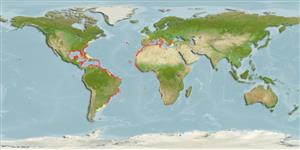Common names from other countries
>
Eupercaria/misc (Various families in series Eupercaria) >
Labridae (Wrasses) > Xyrichtyinae
Etymology: Xyrichtys: Greek, xyreo = that cuts like a knife + Greek, ichthys = fish (Ref. 45335); novacula: Specific name from Latin 'novacula' meaning 'razor'; referring to it being very compressed with front of head forming a sharp edge..
More on author: Linnaeus.
Environment: milieu / climate zone / depth range / distribution range
Sinh thái học
Biển Cùng sống ở rạn san hô; Mức độ sâu 1 - 90 m (Ref. 3726). Subtropical
Western Atlantic: North Carolina, USA and northern Gulf of Mexico (Ref. 7251) through the Caribbean to Brazil. Eastern Atlantic: France to Angola and including the Mediterranean, Azores, Madeira, Canary Islands, Cape Verde and Sao Tome Island.
Bộ gần gũi / Khối lượng (Trọng lượng) / Age
Maturity: Lm ? range ? - ? cm
Max length : 38.0 cm TL con đực/không giới tính; (Ref. 7251); common length : 20.0 cm TL con đực/không giới tính; (Ref. 2683); Tuổi cực đại được báo cáo: 8 các năm (Ref. 4742)
Các tia vây lưng cứng (tổng cộng) : 9; Các vây lưng mềm (tổng cộng) : 12; Tia cứng vây hậu môn: 3; Tia mềm vây hậu môn: 12. An elongate, very compressed fish with front of head forming a sharp edge. Snout very blunt; profile steep. Pale greenish, usually with no conspicuous markings on body (Ref. 26938). Head with alternating vertical lines of light blue and light yellow-orange (Ref. 13442).
Inhabits clear shallow areas with sandy bottoms, usually in the vicinity of seagrass beds and corals (Ref. 2683). Feeds mainly on mollusks; also crabs and shrimps (Ref. 3726). A protogynous hermaphrodite; sexual dimorphism apparent in head shape and length of pelvic fin (Ref. 5292). Builds nests with coral debris. Dives head first into the sand when frightened (Ref. 9710). Marketed fresh (Ref. 3726).
Life cycle and mating behavior
Maturities | Sự tái sinh sản | Spawnings | Egg(s) | Fecundities | Ấu trùng
Gomon, M.F. and P. Forsyth, 1990. Labridae. p. 868-882. In J.C. Quero, J.C. Hureau, C. Karrer, A. Post and L. Saldanha (eds.) Check-list of the fishes of the eastern tropical Atlantic (CLOFETA). JNICT, Lisbon, SEI, Paris; and UNESCO, Paris. Vol. 2. (Ref. 5292)
IUCN Red List Status (Ref. 130435)
CITES (Ref. 128078)
Not Evaluated
Threat to humans
Harmless
Human uses
Các nghề cá: buôn bán nhỏ; cá để chơi: đúng; Bể nuôi cá: Tính thương mại
Các công cụ
Special reports
Download XML
Các nguồn internet
Estimates based on models
Preferred temperature (Ref.
115969): 17.4 - 27.9, mean 24.4 (based on 858 cells).
Phylogenetic diversity index (Ref.
82804): PD
50 = 0.5005 [Uniqueness, from 0.5 = low to 2.0 = high].
Bayesian length-weight: a=0.00955 (0.00680 - 0.01341), b=3.00 (2.90 - 3.10), in cm Total Length, based on LWR estimates for this species (Ref.
93245).
Mức dinh dưỡng (Ref.
69278): 3.5 ±0.1 se; based on diet studies.
Thích nghi nhanh (Ref.
120179): Trung bình, thời gian nhân đôi của chủng quần tối thiểu là 1.4 - 4.4 năm (tmax=8).
Fishing Vulnerability (Ref.
59153): Moderate vulnerability (36 of 100).
